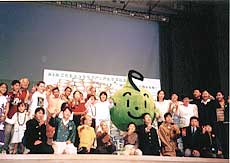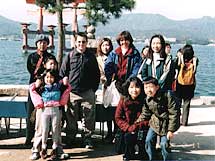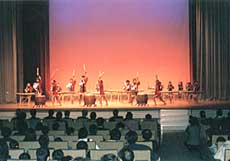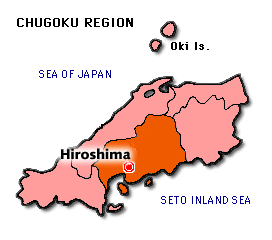



Kids From Around the World Meet to Discuss the Environment
 The Second Asia-Pacific Junior Eco-Club Conference,
sponsored in part by the Ministry of Environment, was held from February 10
to 12, 2001, on the theme "Mother of the Earth: Saving the Sea for the Future."
Kids from all over the world who are involved in environmental efforts gathered
to discuss what can be done to help save the Earth. Whereas the
first meeting in 1999 was held in Tokyo, this gathering took place in the
city of Hiroshima on the beautiful Hiroshima Bay.
The Second Asia-Pacific Junior Eco-Club Conference,
sponsored in part by the Ministry of Environment, was held from February 10
to 12, 2001, on the theme "Mother of the Earth: Saving the Sea for the Future."
Kids from all over the world who are involved in environmental efforts gathered
to discuss what can be done to help save the Earth. Whereas the
first meeting in 1999 was held in Tokyo, this gathering took place in the
city of Hiroshima on the beautiful Hiroshima Bay.
 Sixteen elementary and middle school students
from nine countries--Australia, Britain, China, Kenya, Malaysia, the Philippines,
South Korea, Thailand, and the United States--were invited to the conference
as representatives of their countries, along with members of 10 Eco-Clubs active
in Hiroshima Prefecture. The national representatives reported on the environmental
activities they are involved in.
Sixteen elementary and middle school students
from nine countries--Australia, Britain, China, Kenya, Malaysia, the Philippines,
South Korea, Thailand, and the United States--were invited to the conference
as representatives of their countries, along with members of 10 Eco-Clubs active
in Hiroshima Prefecture. The national representatives reported on the environmental
activities they are involved in.
Before attending the conference, the national
representatives visited various sites around Hiroshima, including the sea of
Hiroshima Bay and an aquarium on Miyajima, which is home to the
UNESCO World Heritage-listed Itsukushima Shrine.
 The main meeting on February 12 was held
at Phoenix Hall in the International Conference Center Hiroshima, which is located
in the Hiroshima Peace Park. About 550 elementary and middle school students
attended. A stirring ryujindaiko (traditional Japanese drum) performance
by 16 students from Tojo Municipal Kushiro Elementary School in Hiroshima Prefecture
marked the opening of the conference. Then, each national representative made
a speech, introduced by fourth-grader Ryuta Yokozaki and other students of Itsuka
Town Minami Elementary School, who acted as MCs.
The main meeting on February 12 was held
at Phoenix Hall in the International Conference Center Hiroshima, which is located
in the Hiroshima Peace Park. About 550 elementary and middle school students
attended. A stirring ryujindaiko (traditional Japanese drum) performance
by 16 students from Tojo Municipal Kushiro Elementary School in Hiroshima Prefecture
marked the opening of the conference. Then, each national representative made
a speech, introduced by fourth-grader Ryuta Yokozaki and other students of Itsuka
Town Minami Elementary School, who acted as MCs.
 Chinese representatives Chen Yuitin (14)
and Peng Shan (15) touched on the floods that devastated China's Yangtze River
in 1998 in their report. They said, "Decreases in the amount of forests and
trees were a big factor in the floods. The air is also terribly polluted, and
many kids are planting trees in their schools and towns in order to stop air
pollution."
Chinese representatives Chen Yuitin (14)
and Peng Shan (15) touched on the floods that devastated China's Yangtze River
in 1998 in their report. They said, "Decreases in the amount of forests and
trees were a big factor in the floods. The air is also terribly polluted, and
many kids are planting trees in their schools and towns in order to stop air
pollution."
Thailand's representative Oranit Eangchoun
(13) remarked that as a popular destination for overseas tourists, Thailand
is facing such problems as large amounts of garbage and the destruction of nature
by resort development. Philippine representatives, including Rachel K. Escueta
(13) , explained that garbage ia a serious problem in the Manila metropolitan
area.
 Syed Mohd Hadi bin Syed Hilmi (15), Malaysia's
representative, appealed to all those present: "Oil spills and illegal dumping
of waste is causing major damage to marine life. Malaysia has made strict laws
and is trying to cut down on waste, but we all need to work together. Let's
protect marine life together!"
Syed Mohd Hadi bin Syed Hilmi (15), Malaysia's
representative, appealed to all those present: "Oil spills and illegal dumping
of waste is causing major damage to marine life. Malaysia has made strict laws
and is trying to cut down on waste, but we all need to work together. Let's
protect marine life together!"
Australian representative Samuel J. Cocsh
(12) is active as a member of his school's Aqua Kids environmental club. He
told the conference that the club has surveyed the sea around coral reefs, collected
data on fish and other marine life, and made the data available on the Internet.
 Japanese representatives Naoya Sakamoto
(14) and Masa Tsuge (14) of the Hiroshima
University Fukuyama Middle School Eco Club reported that in their observations
of acid rain, "The rain showed higher levels of acidity than vinegar or fruit
juice." They announced that they had also posted the results of their observations
on the Internet through the Globe
Program (Global Learning and Observations to Benefit the Environment), which
links schools involved in environmental observation around the world. Members
of the audience also had the chance to give their opinions.
Japanese representatives Naoya Sakamoto
(14) and Masa Tsuge (14) of the Hiroshima
University Fukuyama Middle School Eco Club reported that in their observations
of acid rain, "The rain showed higher levels of acidity than vinegar or fruit
juice." They announced that they had also posted the results of their observations
on the Internet through the Globe
Program (Global Learning and Observations to Benefit the Environment), which
links schools involved in environmental observation around the world. Members
of the audience also had the chance to give their opinions.
Finally, the conference
agreed on a list of 12 calls for action, including, "The mountains, rivers,
and sea are all connected. Let's make sure their circulation is not cut off!"
The conference closed with everyone promising to act to solve problems that
affect the whole Earth.
Photos: (From top) Representatives at the Second Asia-Pacific Junior
Eco-Club Conference; participants visit Itsukushima Shrine on Miyajima; the Conference
opens with a Ryujindaiko performance; touring Hiroshima Bay by ship before
the Conference; representatives onboard a Maritime Safety Agency patrol ship;
participants learn how to make origami.


 The Second Asia-Pacific Junior Eco-Club Conference,
sponsored in part by the Ministry of Environment, was held from February 10
to 12, 2001, on the theme "Mother of the Earth: Saving the Sea for the Future."
Kids from all over the world who are involved in environmental efforts gathered
to discuss what can be done to help save the Earth. Whereas
The Second Asia-Pacific Junior Eco-Club Conference,
sponsored in part by the Ministry of Environment, was held from February 10
to 12, 2001, on the theme "Mother of the Earth: Saving the Sea for the Future."
Kids from all over the world who are involved in environmental efforts gathered
to discuss what can be done to help save the Earth. Whereas  Sixteen elementary and middle school students
from nine countries--Australia, Britain, China, Kenya, Malaysia, the Philippines,
South Korea, Thailand, and the United States--were invited to the conference
as representatives of their countries, along with members of 10 Eco-Clubs active
in Hiroshima Prefecture. The national representatives reported on the environmental
activities they are involved in.
Sixteen elementary and middle school students
from nine countries--Australia, Britain, China, Kenya, Malaysia, the Philippines,
South Korea, Thailand, and the United States--were invited to the conference
as representatives of their countries, along with members of 10 Eco-Clubs active
in Hiroshima Prefecture. The national representatives reported on the environmental
activities they are involved in. The main meeting on February 12 was held
at Phoenix Hall in the International Conference Center Hiroshima, which is located
in the Hiroshima Peace Park. About 550 elementary and middle school students
attended. A stirring ryujindaiko (traditional Japanese drum) performance
by 16 students from Tojo Municipal Kushiro Elementary School in Hiroshima Prefecture
marked the opening of the conference. Then, each national representative made
a speech, introduced by fourth-grader Ryuta Yokozaki and other students of Itsuka
Town Minami Elementary School, who acted as MCs.
The main meeting on February 12 was held
at Phoenix Hall in the International Conference Center Hiroshima, which is located
in the Hiroshima Peace Park. About 550 elementary and middle school students
attended. A stirring ryujindaiko (traditional Japanese drum) performance
by 16 students from Tojo Municipal Kushiro Elementary School in Hiroshima Prefecture
marked the opening of the conference. Then, each national representative made
a speech, introduced by fourth-grader Ryuta Yokozaki and other students of Itsuka
Town Minami Elementary School, who acted as MCs. Chinese representatives Chen Yuitin (14)
and Peng Shan (15) touched on the floods that devastated China's Yangtze River
in 1998 in their report. They said, "Decreases in the amount of forests and
trees were a big factor in the floods. The air is also terribly polluted, and
many kids are planting trees in their schools and towns in order to stop air
pollution."
Chinese representatives Chen Yuitin (14)
and Peng Shan (15) touched on the floods that devastated China's Yangtze River
in 1998 in their report. They said, "Decreases in the amount of forests and
trees were a big factor in the floods. The air is also terribly polluted, and
many kids are planting trees in their schools and towns in order to stop air
pollution." Syed Mohd Hadi bin Syed Hilmi (15), Malaysia's
representative, appealed to all those present: "Oil spills and illegal dumping
of waste is causing major damage to marine life. Malaysia has made strict laws
and is trying to cut down on waste, but we all need to work together. Let's
protect marine life together!"
Syed Mohd Hadi bin Syed Hilmi (15), Malaysia's
representative, appealed to all those present: "Oil spills and illegal dumping
of waste is causing major damage to marine life. Malaysia has made strict laws
and is trying to cut down on waste, but we all need to work together. Let's
protect marine life together!" Japanese representatives Naoya Sakamoto
(14) and Masa Tsuge (14) of the
Japanese representatives Naoya Sakamoto
(14) and Masa Tsuge (14) of the